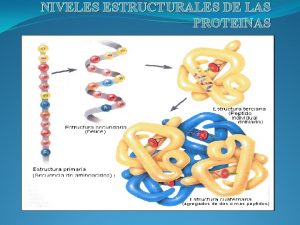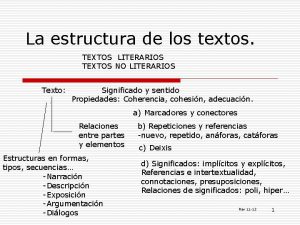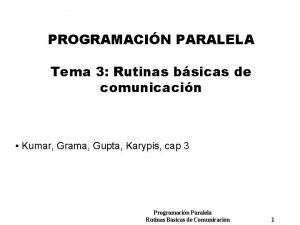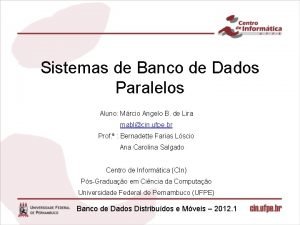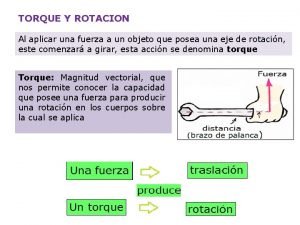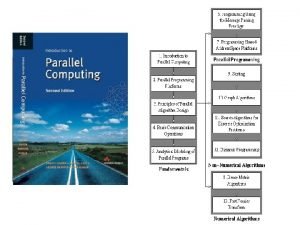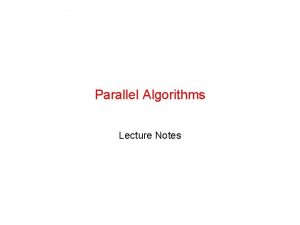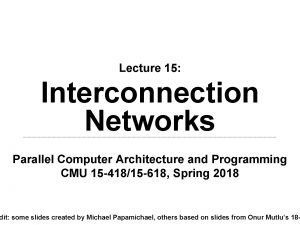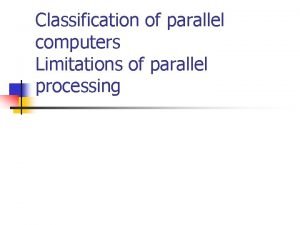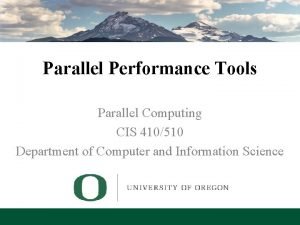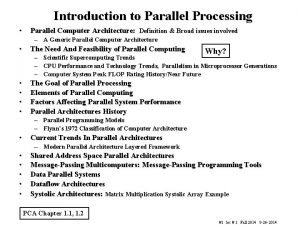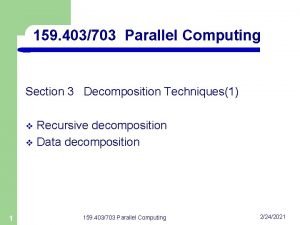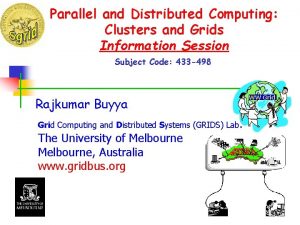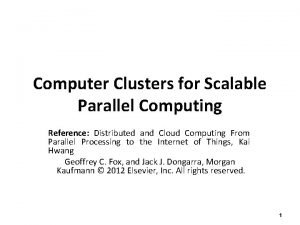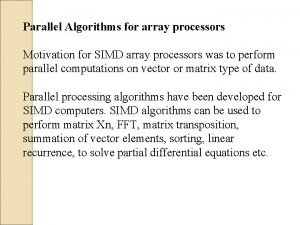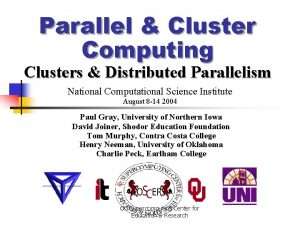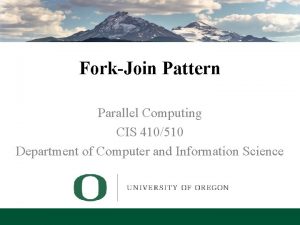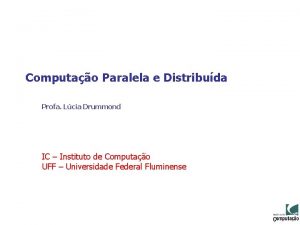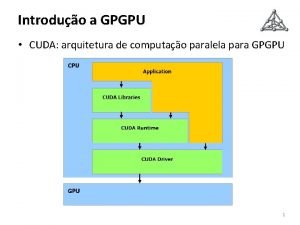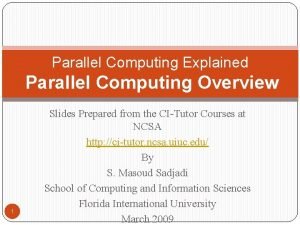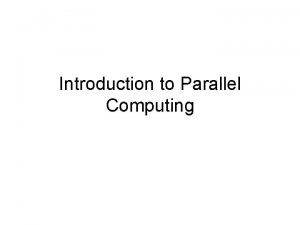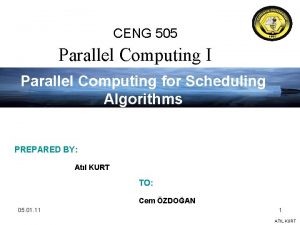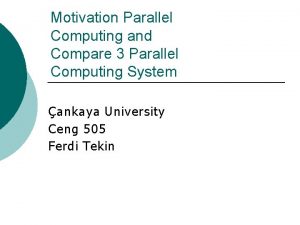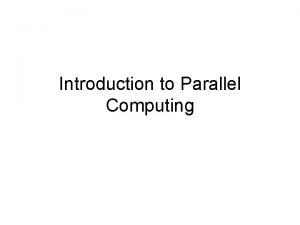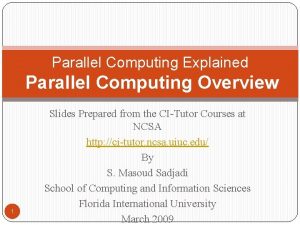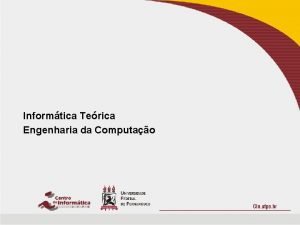Computao Paralela Paralell Computing Parallel Computing In the





































- Slides: 37

Computação Paralela Paralell Computing

Parallel Computing • In the simplest sense, parallel computing is the simultaneous use of multiple compute resources to solve a computational problem: – A problem is broken into discrete parts that can be solved concurrently – Each part is further broken down to a series of instructions – Instructions from each part execute simultaneously on different processors – An overall control/coordination mechanism is employed

Paralell Computing

The Computational Problem • The computational problem should be able to: – Be broken apart into discrete pieces of work that can be solved simultaneously; – Execute multiple program instructions at any moment in time; – Be solved in less time with multiple compute resources than with a single compute resource.

Compute Resources • The compute resources for paralell computing are typically: – A single computer with multiple processors/cores. – An arbitrary number of such computers connected by a network.

Open. MP Programming Model

Shared Memory Model • Uniform Memory Access • Non-Uniform Memory Access

Open. MP Shared Memory Model • Open. MP is designed for multi-processor/core, shared memory machines. • The underlying architecture can be shared memory UMA or NUMA.

Open. MP Thread Based Parallelism • Open. MP programs accomplish parallelism exclusively through the use of threads. • A thread of execution is the smallest unit of processing that can be scheduled by an operating system. The idea of a subroutine that can be scheduled to run autonomously might help explain what a thread is.

Open. MP Thread Based Parallelism • Threads exist within the resources of a single process. Without the process, they cease to exist. • Typically, the number of threads match the number of machine processors/cores. However, the actual use of threads is up to the application.

Open MP Explicit Parallelism • Open. MP is an explicit (not automatic) programming model, offering the programmer full control over parallelization. • Parallelization can be as simple as taking a serial program and inserting compiler directives. . . • Or as complex as inserting subroutines to set multiple levels of parallelism, locks and even nested locks.

Open. MP Fork - Join Model • Open. MP uses the fork-join model of parallel execution:

Open MP Fork - Join Model • All Open. MP programs begin as a single process: the master thread. • The master thread executes sequentially until the first parallel region construct is encountered.

Open. MP Fork - Join Model • FORK: the master thread then creates a team of parallel threads. • The statements in the program that are enclosed by the parallel region construct are then executed in parallel among the various team threads.

Open. MP Fork - Join Model • JOIN: When the team threads complete the statements in the parallel region construct, they synchronize and terminate, leaving only the master thread. • The number of parallel regions and the threads that comprise them are arbitrary.

Open. MP Compiler Directive Based • Most Open. MP parallelism is specified through the use of compiler directives which are imbedded in C/C++ or Fortran source code.

Open. MP Nested Parallelism • The API provides for the placement of parallel regions inside other parallel regions. • Implementations may or may not support this feature.

Open. MP Dynamic Threads • The API provides for the runtime environment to dynamically alter the number of threads used to execute parallel regions. • Intended to promote more efficient use of resources, if possible. • Implementations may or may not support this feature.

Open. MP I/O = Input/Output • Open. MP specifies nothing about parallel I/O. This is particularly important if multiple threads attempt to write/read from the same file. • If every thread conducts I/O to a different file, the issues are not as significant. • It is entirely up to the programmer to ensure that I/O is conducted correctly within the context of a multithreaded program.

Open. MP API Overview

Three Components (1) As of version 4. 0: Compiler • The Open. MP API is comprised of three distinct components. – Compiler Directives (44) – Runtime Library Routines (35) – Environment Variables (13)

Three Components (2) • The application developer decides how to employ these components. • In the simplest case, only a few of them are needed.

Three Components (3) • Implementations differ in their support of all API components. • For example, an implementation may state that it supports nested parallelism, but the API makes it clear that may be limited to a single thread - the master thread. • Not exactly what the developer might expect?

Compiler Directives • Compiler directives appear as comments in your source code and are ignored by compilers unless you tell them otherwise usually by specifying the appropriate compiler flag, as discussed in the Compiling section later.

Compiler Directives • Open. MP compiler directives are used for various purposes: Spawning a parallel region. • Dividing blocks of code among threads. • Distributing loop iterations between threads. • Serializing sections of code. • Synchronization of work among threads.

• Compiler directives have the following syntax: sentinel directive-name [clause, . . . ] • For C/C++ Example : #pragma omp parallel default(shared) private(beta, pi)

MPI = Message Passing Interface • Message Passing Interface (MPI) é um padrão para comunicação de dados em computação paralela. Existem várias modalidades de computação paralela, e dependendo do problema que se está tentando resolver, pode ser necessário passar informações entre os vários processadores ou nodos de um cluster, e o MPI oferece uma infraestrutura para essa tarefa.

MPI = Message Passing Interface • No padrão MPI, uma aplicação é constituída por um ou mais processos que se comunicam, acionando-se funções para o envio e recebimento de mensagens entre os processos.

MPI = Message Passing Interface • O objetivo de MPI é prover um amplo padrão para escrever programas com passagem de mensagens de forma prática, portátil, eficiente e flexível. • MPI não é um IEEE ou um padrão ISO, mas chega a ser um padrão industrial para o desenvolvimento de programas com troca de mensagens.

Open. CL • Open. CL (Open Computing Language) é uma arquitetura para escrever programas que funcionam em plataformas heterogêneas, consistindo em CPUs, GPUs e outros processadores. Open. CL inclui uma linguagem (baseada em C 99) para escrever kernels (funções executadas em dispositivos Open. CL), além de APIs que são usadas para definir e depois controlar as plataformas heterogênea. • Open. CL permite programação paralela usando, tanto o paralelismo de tarefas, como de dados.

Open. CL • Ela foi adotada para controladores de placas gráficas pela AMD/ATI, que a tornou na sua única oferta de GPU como Stream SDK, e pela Nvidia. • Nvidia oferece também Open. CL como a escolha para o seu Compute Unified Device Architecture (CUDA) nos seus controladores. • A arquitetura Open. CL partilha uma série de interfaces computacionais, tanto com CUDA, como com a concorrente Direct. Compute da Microsoft.

Open. CL • A proposta Open. CL é similar às propostas Open. GL e Open. AL, que são padrões abertos da indústria para gráficos 3 D e áudio, respectivamente. • Open. CL estende o poder da GPU além do uso gráfico (GPGPU). • Open. CL é gerido pelo consórcio tecnológico Khronos Group.

CUDA A Scalable Programming Model • http: //docs. nvidia. com/cuda-c-programmingguide/#axzz 4 B 2 Dg. Q 0 WL • The advent of multicore CPUs and manycore GPUs means that mainstream processor chips are now parallel systems. • In parallel computing, a barrier is a type of synchronization method. A barrier for a group of threads in the source code means any thread must stop at this point and cannot proceed until all other threads/processes reach this barrier.

CUDA

CUDA

CUDA

CUDA
 Current in parallel vs series
Current in parallel vs series Owl purdue parallel structure
Owl purdue parallel structure Parallelism grammar definition
Parallelism grammar definition Snap circuits instructions
Snap circuits instructions Esquadro isósceles
Esquadro isósceles Pendiente positiva y negativa
Pendiente positiva y negativa Linha paralela e perpendicular
Linha paralela e perpendicular Lamina beta paralela y antiparalela
Lamina beta paralela y antiparalela Pontos complanares
Pontos complanares Estructura del texto poetico
Estructura del texto poetico Paralēli nogriežņi
Paralēli nogriežņi Trace uma reta paralela à reta r
Trace uma reta paralela à reta r Abscissas e ordenadas
Abscissas e ordenadas Segmentos de reta perpendiculares
Segmentos de reta perpendiculares Programacion paralela
Programacion paralela Reta perpendicular
Reta perpendicular Ejemplo de estructura paralela
Ejemplo de estructura paralela Arquitetura paralela banco de dados
Arquitetura paralela banco de dados Tipos de torque física
Tipos de torque física Transmision paralela
Transmision paralela Mary likes hiking swimming and to ride a bicycle
Mary likes hiking swimming and to ride a bicycle Differentiate between like and unlike parallel forces
Differentiate between like and unlike parallel forces Shift register truth table
Shift register truth table What are the two focal points of fingerprints?
What are the two focal points of fingerprints? Parallelism refers to
Parallelism refers to Introduction to parallel computing ananth grama
Introduction to parallel computing ananth grama Parallel distributed computing
Parallel distributed computing Explicitly parallel instruction computing
Explicitly parallel instruction computing Cmu parallel computing
Cmu parallel computing Gustafson’s law
Gustafson’s law In parallel computing
In parallel computing Parallel computing definition
Parallel computing definition Recursive decomposition in parallel computing
Recursive decomposition in parallel computing Cluster in parallel and distributed computing
Cluster in parallel and distributed computing Design principles of computer clusters
Design principles of computer clusters Associative array processing in parallel computing
Associative array processing in parallel computing Distributed, parallel, and cluster computing
Distributed, parallel, and cluster computing In parallel computing
In parallel computing







